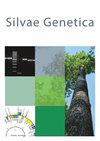摘要:建立一套新的SNP标记来测量蒙古栎(Quercus mongolica Fisch)的遗传多样性和遗传分化。前Ledeb.)在俄罗斯远东
IF 1
4区 农林科学
Q3 FORESTRY
引用次数: 2
摘要
摘要/ Abstract摘要:本研究获得了25个核(nc)、12个叶绿体(cp)和7个线粒体(mt) snp,并用于371蒙古栎(Quercus mongolica Fisch)的基因型分析。(ex Ledeb.)在俄罗斯远东200公里乘400公里的区域内的7个地点种植树木。在乌苏里斯克市以东15公里乘25公里的区域内,对其中一个地点进行了更深入的分析,收集了188棵树。在核snp上的遗传分化是小到中等的,在质体snp上的遗传分化是高的。21对中有19对在地理位置上的基因库距离具有统计学显著性。遗传距离与空间距离无相关性。仅鉴定出三种不同的多位点单倍型,42个双位点组合的质体snp可用于鉴定它们。讨论了对木材跟踪和基因保护等实际应用的结论。本文章由计算机程序翻译,如有差异,请以英文原文为准。
Short note: Development of a new set of SNP markers to measure genetic diversity and genetic differentiation of Mongolian oak (Quercus mongolica Fisch. ex Ledeb.) in the Far East of Russia
Abstract We developed a new set of 25 nuclear (nc), 12 chloroplast (cp) and 7 mitochondrial (mt) SNPs and used it to genotype 371 Mongolian oak (Quercus mongolica Fisch. ex Ledeb.) trees from seven locations in a 200 km by 400 km area in the Russian Far East. One of the locations in an area of 15 km by 25 km east of the city Ussuriusk was analyzed more intensively with 188 collected trees. The genetic differentiation at the nuclear SNPs was small to moderate and for the plastid SNPs it was high when considering all trees from the seven locations. The gene pool distances between locations were for 19 out of 21 pairs statistically highly significant. There was no correlation of genetic and spatial distances. Only three different multilocus-haplotypes could be identified and 42 two-loci-combinations of plastid SNPs could be used to identify them. Conclusions for the practical application such as timber tracking and gene conservation are discussed.
求助全文
通过发布文献求助,成功后即可免费获取论文全文。
去求助
来源期刊

Silvae Genetica
农林科学-林学
CiteScore
2.20
自引率
10.00%
发文量
10
审稿时长
3 months
期刊介绍:
Silvae Genetica is an international peer reviewed journal with more than 65 year tradition and experience in all fields of theoretical and applied Forest Genetics and Tree breeding. It continues "Zeitschrift für Forstgenetik und Forstpflanzenzüchtung" (Journal of Forest Genetics and Forest Tree Breeding) founded by W. LANGNER in 1951.
 求助内容:
求助内容: 应助结果提醒方式:
应助结果提醒方式:


